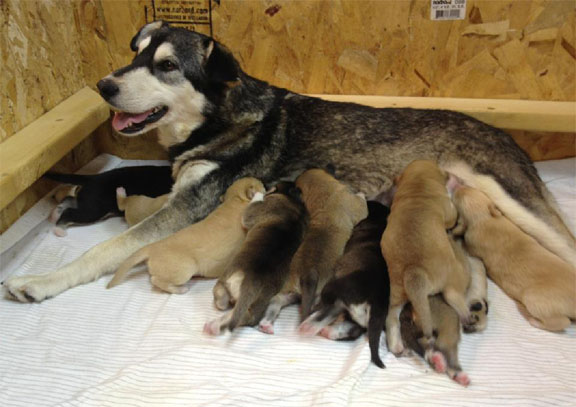Continued
Having already discussed the important matters that surround the pre-whelping period, we’ll concentrate today on the issues associated with labour and the actual delivery.
There are three stages of labour. In the first stage the cervix (the canal connecting the vagina with the womb) dilates and opens up the birth canal. In the second stage the puppies are delivered alternately from the ‘horns’ of the uterus. You may recall that I had mentioned that the uterus (womb) of a dog is not like that of a woman. The bitch’s womb is shaped like a ‘Y’; the two arms of the ‘Y’ are called horns, and it is here where the pups reside until they are delivered. The upright of the ‘Y’ is called the body of the Uterus. In the third stage the afterbirth is delivered. Bitches lie down or stand or squat to deliver their offspring.
The first stage begins with rapid panting, uneasiness, straining or perhaps vomiting. During this period, vomiting could be considered a normal reflex, and should not be taken as a sign of distress.

After the head is delivered, the rest of the puppy slides out easily. Instinctively the mother removes the foetal membranes, severs the umbilical cord and begins to lick and clean her puppies. No attempt should be made to interfere with maternal care. This is an important part of the mother-puppy bond. She is learning that this is her puppy, and she must take care of it. If she appears rough, it is usually only because she is trying to stimulate breathing and blood circulation.
If the mother is occupied with another puppy and forgets to remove the bag (amniotic sac), you should be prepared to step in and strip away the foetal membranes, so that the puppy can breathe.

Bitches sever the umbilical cord by shredding it. If the cord is cut too cleanly or too close to the puppy’s navel it may continue to bleed. You should be prepared to clamp or pinch off the cord and tie a thread around the stump. The stump could be sanitized with iodine or some other suitable disinfectant.
The next puppy will be born from the opposite uterine horn, and this delivery process continues alternately, until all the pups have been born.
Next week, we’ll continue with advice relating to the assistance you, the owner; can give during this whelping period.
Incorrect ‘practice’
Before we close off today, there is an issue which I would like to share with you. It has to do with some more comments on untrained quacks who are ‘practising’ veterinary medicine under no supervision whatsoever (see also February, 10, 2013). On some occasions, a qualified veterinarian might tacitly give his/her name as the mentor/supervisor of these ‘technicians,’ without ever really looking into the activities of the charlatans.
A lot of the blame for allowing the untrained ‘practitioner’ to touch a sick dog must fall on the owners themselves. My colleague Dr Waldron, is quite firm in his position. He writes that companion animal owners “have a responsibility to ensure that their pets get genuine veterinary care that the animal actually needs and not what is convenient to the owner.” The owner must be aware of the limitations of even qualified Animal Health Assistants, since the latter, Dr Waldron, maintains “are not adequately equipped to diagnose and treat ill animals, nor can they legally prescribe and use certain types of drugs.” I agree with Dr Waldron.
Of course, it follows that shops retailing pet care products and chemicals destined for large animals are getting into the act of ‘dispensing’ serious drugs across the counter – without prescription. It has come to our attention that one such animal product supplier is actually selling hormones (with syringes and needles) that are supposed to stop the pets coming into heat, or to prohibit pregnancy or to abort the foetus. The negative and life-threatening consequences of such unskilled hormonal intervention are presented to the genuine veterinarian, who has then to try alleviating (usually via difficult surgery) the suffering from severe reproductive disorders, not always successfully.
The public must be reminded that the misuse of certain medicines (in both pets and livestock) could lead to serious animal health and human health complications. Most of the ‘practices,’ alluded to above, are illegal. The Guyana Veterinary Association and the Guyana Police Force will have to take action against such abominations.





